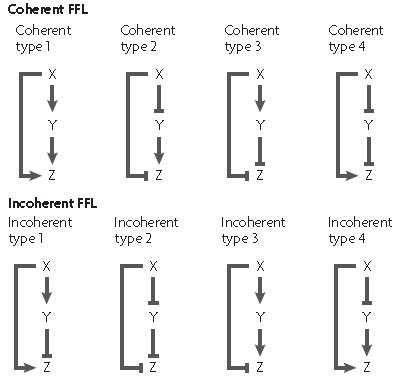Lecture 21
Feedforward Loops
Recall the different types of feedforward loops. Last lecture we discussed the behavior of the C1 loop. The advantage of the C1 loop is that it protects Z from turning on due to fluctuations in X. This is called a persistence detector.
Now we will examine the behavior of some of the incoherent feedforward loops.
I1 Loop
Assume that the signals from X and Y combine in an AND NOT logic fashion to create output Z.
| Transcription Rate | X | Y |
|---|---|---|
| \(0\) | \(0\) | \(0\) |
| \(0\) | \(0\) | \(>0\) |
| \(k\) | \(>0\) | \(0\) |
| \(k'<< k\) | \(>0\) | \(>0\) |
As in the previous lecture, assume that the concentration of X quickly turns on at time \(t=0\).
\[y(t) = y^* \left( 1 - e^{-r_yt} \right)\] \[z(t) = \begin{cases} z_\text{max} \left( 1 - e^{-r_zt} \right) , & t < \tau \\ z^*+(z_y-z^*)e^{-r_z(t-\tau)}, & t > \tau \end{cases}\] \[\tau = \frac{1}{r_y}\ln\left( \frac{1}{1-K/y^*} \right) \\ \frac{z^*}{z_\text{max}} = \frac{k'}{k} = \frac{1}{F} \\ F \equiv \text{Repression Factor}\] \[\tau_{1/2} = \frac{1}{r_z}\ln\left( \frac{2F}{2F-1} \right) \\ \tau_{1/2} = \begin{cases} 0, & F>>1 \\ \frac{1}{r_z}\ln 2, & F = 1 \end{cases}\]In summary, there are three ways to speed up response.
- Auto-repression
- Incoherent feedforward loop
- Increase the degradation rate r and increase the production rate k.
Written with StackEdit.
Written on April 3, 2015

